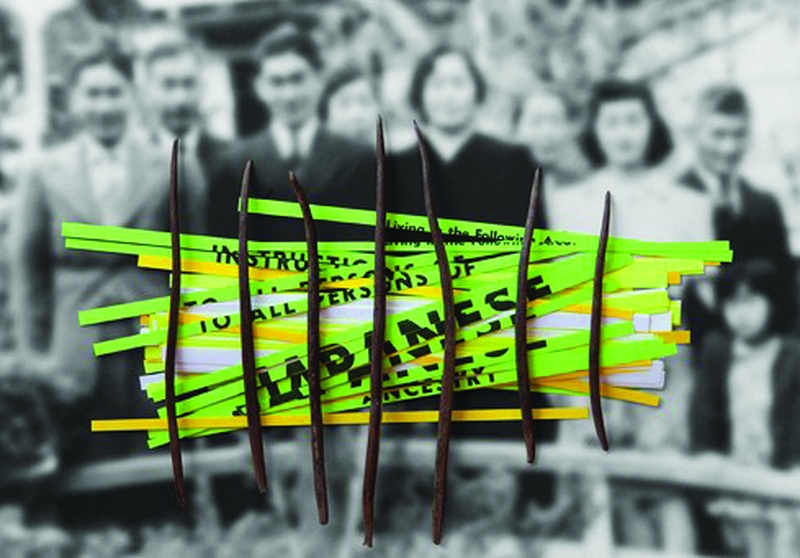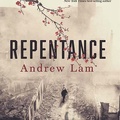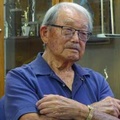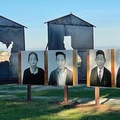Sansei (third generation American born) Japanese Americans often have prior family histories that have been blacked out; their Nisei (second generation) parents who were imprisoned by the U.S. Government during World War II never talked about it.
It was too painful an experience, one they desperately wanted to forget.
“Through their silence my family protected me from what happened to them, but silence is a powerful transmitter of emotional trauma—there’s no statute of limitations,” said Monterey-based photographer, designer, and writer Jerry Takigawa. “After the war my ancestor’s shame and silence turned into a shadow legacy for the next generation, my generation, the Sansei.”
To give voice and meaning to this figurative “lost” generation, the Monterey Museum of Art (559 Pacific St., Monterey, CA) is hosting an exhibition titled Shadows from the Past: Sansei Artists and the American Concentration Camps.
The exhibition currently on display will run through Jan. 8, 2022. The display features paintings, photographs, and sculptures by eight renowned artists including Takigawa, intended as a presentation of selected works that define the personal and collective impact of the imprisonment on the prisoners, but also their descendants.
In early 1942, the U.S. Government decided that 120,000 people of Japanese ancestry most of them American citizens living along the West Coast, were a threat. They were arrested, deported, lost their homes, jobs and property, and imprisoned in a dozen barbed-wire-guarded camps many in remote areas of the Desert Southwest. The War Relocation Authority operated the camps, while the Dept. of Justice (DOJ) ran its own smaller camps housing prisoners.
The camps were often sited in dusty and windblown barren locations, blazing hot in summer and freezing cold in winter.
The prisoners included the elderly and children.
Adults were forced to fill out a questionnaire to state their loyalty which if they did, did not grant them release. If they questioned the legality of their imprisonment or filled out the form in a manner that did not please their jailors they were sent to special camps for “troublemakers,” such as Tule Lake in Northeastern California.
Formerly the imprisonment was called an “internment.” The more common usage today is to call them “concentration camps” because they were racially motivated. Internment, which almost sounds legitimate, applies to the legal but morally questionable imprisonment of enemy aliens during a war.
What happened to Japanese American citizens was illegal and immoral. The U.S. Government finally admitted so in the 1980’s and offered reparations to camp survivors. Former President Gerald Ford called the imprisonment our “National Mistake.”
The Shadows from the Past exhibit also displays historical artifacts from the camps and the impact the incarceration had on Japanese Americans who lived in Monterey, a major labor pool who helped to develop the region’s fishing and farming industries.
Painter and print maker Tom Nakashima created a drawing for the exhibit called “Tule Lake Jail for Ted, Mako and the Minidoka Nakashimas.” The painting portrays the incarceration of Nakashima’s family members.
“My uncle Ted Nakashima and his wife Masako were confined at the Tule Lake Segregation Camp,” Tom Nakashima said.
Ted had written an essay protesting his and others illegal imprisonment and submitted it to New Republic Magazine, the piece titled, “Concentration Camp U.S. Style.” This got him (and his wife) in trouble with authorities. They were separated from other imprisoned family members at Minidoka Camp in Idaho and sent to Tule Lake as a punishment.
Anyone who protested or refused to answer the loyalty questionnaire was labeled a “No No Boy.”
“He (Ted) was considered a trouble maker and I believe he would have been quite outspoken and would have been further segregated in one of the terrible jails within the jail of Tule Lake,” Tom Nakashima said. “These cages or jails were made of steel straps bolted or riveted together. My drawing documents the general appearance of a solitary confinement cell and includes collaged cut-outs from the New Republic article. It celebrates Ted as a hero who stood with his people.”
The drawing also lists family members incarcerated at the Minidoka Camp.
Curator and organizer of the exhibit is Gail Enns. She said for the Sensei generation of artists to speak openly about the inherited trauma and the suffering of their parents after a long silence is a courageous act.
“To create art to be shared in a public setting is powerful and transformative,” Enns said. “The works in Shadows from the Past not only express courage and vulnerability, but also remind viewers of the important role that the arts play in shifting our perspectives about our shared American culture and history.”
Masako Takahashi, an artist who attended the San Francisco Art Institute, is the only exhibition participant displaying artwork who was born in a concentration camp at Topaz, Utah.
“It is a trauma I have lived with since I was born,” she said. “These are feelings that are difficult to speak about. Art can be better than words to say certain things.”
Asked what she hoped visitors seeing the works will come away with, she answered a strong sense of the difference between right and wrong.
“It matters that we remember,” Takahashi said. “But also that we act. What’s been happening on America’s southern border these past few years is familiar to many of us. Never again is now.”
Monterey Museum of Art Executive Director Corey Madden said the exhibit is timely given a recent spate of violence directed at anyone who appears to be Asian, from haters seeking a scapegoat to vent their frustrations.
“Today, as Asian Americans suffer from renewed hatred and violence directed at them, the Monterey Museum of Art reaffirms its commitment to present art and public programming that furthers community belonging, and provides a platform for artistic expression and open dialog,” Madden said. “We are immensely grateful to the artists, curators, scholars and community leaders who have contributed to this timely and relevant exhibition, and we hope it contributes to greater understanding of our shared values and humanity.”
Participating artists showing their works include multi-media artist Reiko Fujii, visual artist and cultural anthropologist Lydia Nakashima Degarrod, cultural history artist Lucien Kubo, culture narrator Na Omi Judy Shintari and artist and furniture-maker Wendy Maruyama.
A number of events are planned as part of the exhibition. On Saturday, Dec. 11 at 10 a.m., the Japanese American Citizens League (JACL) will conduct a virtual panel discussion on the history of the camps and the role of Monterey as a “Sanctuary City.”
Four radio plays as part of the “Japanese American Civil Liberties Collection” will be presented portraying the experiences in the camps staged by L.A. Theatre Works. They will be available for viewing via computer at montereyart.org.
On Saturday, Jan. 8, 2022, the museum will host its Annual Art of the State Symposium, titled “Beyond Identity, Aesthetics: Critical Conversations with California’s Asian American and Pacific Islander Arts Communities.” A day-long live event, the symposium will be a discussion of critical issues among AAPI arts communities and will feature a distinguished advisory board.
General admission to the Shadows from the Past: Sansei Artists and the American Concentration Camps exhibition is $15. Museum members, students, military and children under 18 get in free.
For more information go to montereyart.org/exhibitions.
*This article was originally published on the NikkeiWest.
© 2021 John Sammon / NikkeiWest






